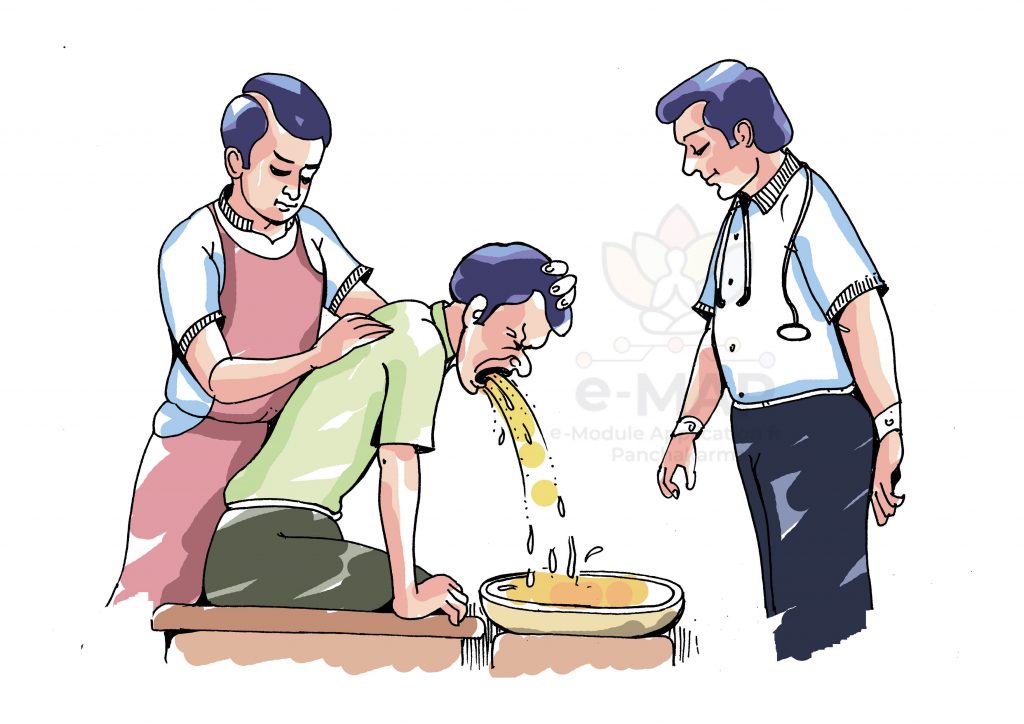
UG Module 4 - Lesson 10
VAMANA KARMA

EXPLANATORY NOTES
तत्रोष्णतीक्ष्णसूक्ष्मव्यवायिविकाशीन्यौषधानि स्ववीर्येण हृदयमुपेत्य धमनीरनुसृत्य स्थूलाणुस्रोतोभ्यः केवलं शरीरगतं दोषसङ्घातमाग्नेयत्वाद् विष्यन्दयन्ति, तैक्ष्ण्याद् विच्छिन्दन्ति, स विच्छिन्नः परिप्लवन् स्नेहभाविते काये स्नेहाक्तभाजनस्थमिव क्षौद्रमसज्जन्नणुप्रवणभावादामाशयमागम्योदानप्रणुन्नोऽग्निवाय्वात्मकत्वादूर्ध्वभागप्रभावादौषधस्योर्ध्वमुत्क्षिप्यते, सलिलपृथिव्यात्मकत्वादधोभागप्रभावाच्चौषधस्याधः प्रवर्तते, उभयतश्चोभयगुणत्वात्| इति लक्षणोद्देशः|| (Cha. Ka.1/5)
Vāmaka Dravyās are Uṣna, Tīkṣna, Sūkṣma, Vyavāyi, Vikāśi in nature. By the Vīrya/ potency of the drug, it reaches Hṛdaya and later circulates through the blood vessels. Due to the predominance of Agni Mahābhūta, the drug possesses Āgneya nature. Because of their Tīkṣna Guṇa, they liquefy the adhered Doṣas in the gross and subtle channels (Srotas) of the body. After separation these morbid materials floats in the body channels without adhesion like how honey kept in a pot smeared with fat, the morbid materials finally reach the stomach. By the predominance of Agni and Vāyu Mahābhūta and their Vāmaka Prabhāva (specific action to move upward), the morbid materials get propelled by Udāna Vāyu through the upward tract.
Modern view: Emesis
Vomiting is the forceful evacuation of gastric contents due to the irritation of upper gastro intestinal tract due to some special type of irritative impulses and excessive distension of stomach. The contraction of musculature of the gut and thoracic – abdominal wall plays vital role in the oral expulsion of gastrointestinal contents during vomiting. Vomiting is coordinated by the brain stem and is affected by responses in the gut, pharynx and thoracic abdominal wall.
Pathophysiology of Vomiting Reflex:
Vomiting is a reflex act that is mediated neurologically by the activation of the bilateral nucleus tractus solitarii, or emetic centre, which is expressed in the parvicellular reticular formation in the lateral region of the medulla oblongata. This is the area that initiates, controls, regulates, and organizes the vomiting reflex. Vomiting can be triggered by both neural and humoral pathways. The neural pathway comprises six fundamental components. The emetic centre receives input from the gastrointestinal tract (afferent neurons), the higher centres of the brain, and the vestibular apparatus. Finally, to coordinate the vomiting reflex, the vomiting centre sends signals through the efferent motor neurons. The vagal and sympathetic afferent neurons originate from the gastrointestinal tract, particularly the duodenum, as well as other areas, including the urinary and reproductive system, liver, pancreas, peritoneum, and cardiac vessels. Stimulation of these neurons initiates the impulse that travels directly to the emetic centre. The higher centres of the brain, including the cerebral cortex and the limbic system, can trigger emesis through three mechanisms: direct stimulation of the vomiting centre by inflammatory diseases, hydrocephalus, or neoplasia; psychogenic stimulation caused by fear, stress, excitement, or pain; and traumatic stimulation related to head injuries and increased intracranial pressure. The CRTZ is a bilateral set of centres in the brainstem, located on the floor of the fourth ventricle. It possesses free nerve endings that maintain direct contact with the cerebrospinal fluid via ependymal pores or the sheath surrounding fenestrated capillaries. These free nerve endings are activated by the vestibular system or through the humoral pathway by conditions affecting the blood or cerebrospinal fluid (e.g., drug administration, infection, osmolar and acid–base disorders, electrolyte derangements, metabolic diseases). Finally, to initiate the vomiting reflex, efferent motor signals must be transmitted to the upper gastrointestinal tract through the sensory aspect of cranial nerves V, VII, IX, X, and XII and to the diaphragm and abdominal muscles via the spinal nerves. The act of vomiting is composed of three phases: nausea, retching, and expulsion of proximal duodenal and gastric contents.
Nausea:
The mechanisms underlying nausea are poorly understood, but electroencephalographic studies supported that cerebral cortex is involved in this process because nausea requires conscious perception. Nausea is the conscious recognition of subconscious excitation in an area of the medulla that is closely associated with the vomiting centre. This excitation is caused by irritative impulses coming from the gastrointestinal tract, lower brain, or cerebral cortex. Ptyalism, tachycardia, nervousness, hiding or seeking attention, shivering, and yawning are all characteristic signs of nausea triggered by general activation of the sympathetic and parasympathetic branches of the autonomic nervous system. Hypersalivation stimulates swallowing, which stimulates relaxation of the gastroesophageal sphincter. The bicarbonate-rich saliva secreted by the salivary glands in the mouth lubricates the oesophagus and helps to neutralize the stomach’s acidic environment before vomiting.
Before retching, aboral gastric and oesophageal motility diminishes and the lower oesophageal and pyloric sphincters relax.
Retching:
Retching is the second phase of vomiting and begins with the onset of a retrograde giant contraction. This contraction is a single-phase, retrograde, peristaltic motion that empties the proximal duodenal contents into the stomach. It is followed by deep inspiratory movements, forceful contractions of the muscles of abdomen, diaphragm, and closure of the glottis. These actions produce negative intra-thoracic pressure and positive intraabdominal pressure, facilitating the movement of gastric contents into the oesophagus.
Before expulsion, the respiratory centre is inhibited and the nasopharynx and glottis close to prevent pulmonary aspiration and nasal regurgitation of the gastric contents. The third and last phase of vomiting is the expulsion of stomach contents through the mouth.
IMPORTANT SLOKA
तत्रोष्णतीक्ष्णसूक्ष्मव्यवायिविकाशीन्यौषधानि स्ववीर्येण हृदयमुपेत्य धमनीरनुसृत्य स्थूलाणुस्रोतोभ्यः केवलं शरीरगतं दोषसङ्घातमाग्नेयत्वाद् विष्यन्दयन्ति, तैक्ष्ण्याद् विच्छिन्दन्ति, स विच्छिन्नः परिप्लवन् स्नेहभाविते काये स्नेहाक्तभाजनस्थमिव क्षौद्रमसज्जन्नणुप्रवणभावादामाशयमागम्योदानप्रणुन्नोऽग्निवाय्वात्मकत्वादूर्ध्वभागप्रभावादौषधस्योर्ध्वमुत्क्षिप्यते, सलिलपृथिव्यात्मकत्वादधोभागप्रभावाच्चौषधस्याधः प्रवर्तते, उभयतश्चोभयगुणत्वात्| इति लक्षणोद्देशः|| (Ch.Ka.1/5)
Vāmaka Dravyās are Uṣna, Tīkṣna, Sūkṣma, Vyavāyi, Vikāśi in nature. By the Vīrya/ potency of the drug, it reaches Hṛdaya and later circulates through the blood vessels. Due to the predominance of Agni Mahābhūta, the drug possesses Āgneya nature. Because of their Tīkṣna Guṇa, they liquefy the adhered Doṣas in the gross and subtle channels (Srotas) of the body. After separation these morbid materials floats in the body channels without adhesion like how honey kept in a pot smeared with fat, the morbid materials finally reach the stomach. By the predominance of Agni and Vāyu Mahābhūta and their Vāmaka Prabhāva (specific action to move upward), the morbid materials get propelled by Udāna Vāyu through the upward tract.



